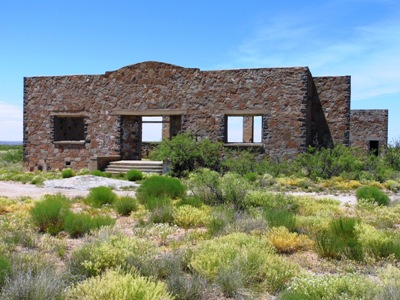
Those of you who are fans of the Roadrunner and Wile E. Coyote might be excited to hear that there was once a town in New Mexico named Acme. However, the corporation which lent its name to the place made cement blocks not jet-propelled unicycles. In the early 1900’s, the Acme Gypsum Cement Company built a mill slightly south of the Clovis Highway (supplanted by present-day U.S. 70), 17 miles northeast of Roswell, where aliens would later badly botch a saucer landing.
In 1907, the Acme School commenced lessons from inside a tent. Later, a one-room frame and plaster school was built on the western edge of town, placed so as to keep the students away from the dust and smoke of the mill. Grades 1-8 were taught and kids had to bring their own books and supplies, along with their lunches.
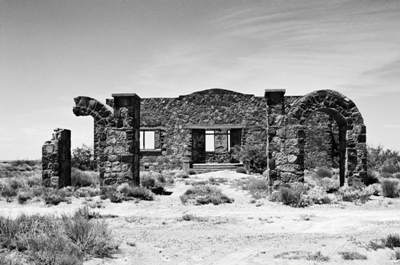
Acme boasted a hotel, large horse barn, general store, depot, and some company houses for workers. Its post office opened in 1906 and closed in 1946, by which time the Acme Gypsum Cement Co. had been out of business for ten years. When the mill closed, it was estimated that there were 30-40 people in Acme, of which 20 were children. Now there is nothing left of Acme at all, except for the cemetery, which is north of U.S. 70, half a mile away from where the mill once crunched gypsum.
One hundred meters from what doesn’t remain of Acme is the photogenic ruin of the Frazier School. So close together that some people seem not to distinguish between Acme and Frazier, their existence overlapped slightly. Frazier was established later and survived longer...but not too much longer. Frazier’s post office opened in 1937, a year after the Acme mill closed. That same year the Frazier School was built. Funeral services were also held in the school since the Acme Cemetery was nearby. I assume that anyone who died in Frazier was also buried in the Acme Cemetery. I also assume funerals weren’t held during class, unless mortuary science was on the curriculum.
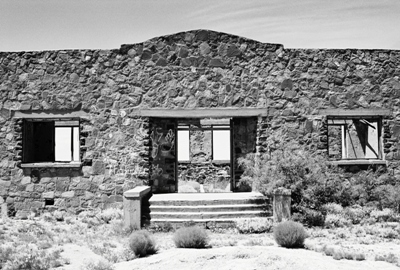
Now, Frazier was a community of folks trying to make it through the ongoing effects of the Great Depression as best they could. Many of those who worked at the Acme Gypsum Cement Co. had moved on and almost the only employment in the area was to be found in the dusty, meagre soil of the eastern plains. Some ranchers did have cattle, and one enterprising rancher is said to have herded turkeys as if they were sheep. Coyote skins could be sold at Bond-Baker Wool and Hide Co. for $1.50-$5.00 per pelt, and the meat of a cottontail rabbit might be worth $1.00. Still, many families lived in dugouts or other similarly challenging shelter.
Yet these homesteaders wanted their children to receive a good education. So, it was C.M. Martin, the Chaves County superintendent, who designated that a new school, larger than the one in Acme, be built on land donated by Otis L. Shields. Then Lake J. Frazier secured a contract with the Works Progress Administration for construction, and thus both the school and the community were named for him. This would be the last one-teacher school built in Chaves County.
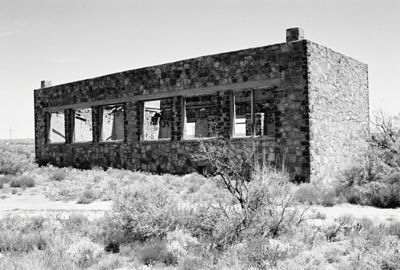
Stones were gathered from the area for building material, and black volcanic rocks framed the windows and doors. White rocks were used to create a five-point star above the front doors, and a steer’s head with longhorns was set in the eastern wall. There was one double-size room with a smaller room on each side partitioned by double doors. There was no electricity, but six large north-facing windows let in lots of sunlight (see photo above). Nor was there running water, but a stone tower out back contained a cistern on top, as well as coal storage below. “WATER” was spelled-out in volcanic rock along the tower’s top (see photo below). Mesquite roots augmented the coal supply when it came to providing heat. Teachers were required to check the route for rattlesnakes before allowing a child to use the outhouse.
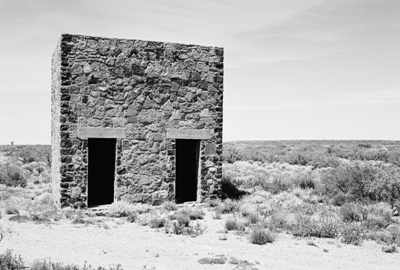
As soon as it was completed, pupils attending the Acme School moved to the Frazier School, as did their teacher, Margaret Harrison. There were 24 kids that first year and Mrs. Harrison boarded with the family of Mac Smith, who ran a store and gas station, as well as the post office. Some students walked to school, but those on ranches were picked up in a car. Horse-drawn implements were used to finally make roads suitable for busses. Mrs. Harrison had already moved to another school by 1938 and teachers came and went frequently in Frazier.
Frazier was an active community through World War II, but, after the war, enrollment in the school dropped below the mandatory eight pupils and it closed in 1945. Students in the area were then sent to Roswell. For a time the school was used a community center, but eventually even the need for that withered. Now, not a soul remains in Frazier and the ruins of the stone school, once the pride of many, are all that marks this place.
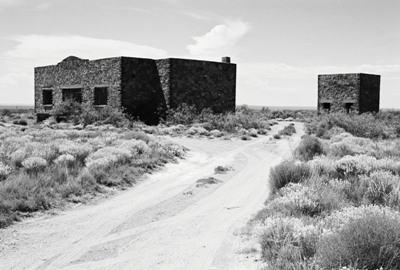
Most information for this post came from The last one-teacher school is special to many, in the December 27, 1996 edition of the Roswell Daily Record, as well as Acme’s heyday was from 1905 until late 1930’s, in the November 29, 1996 edition of the same. Both articles were written by Ernestine Chesser Williams and can be found in her collection, “Chaves County Schools 1881-1968: Treasures of New Mexico History.” The only place that has copies for sale is the Historical Society for Southeast New Mexico in Roswell. As usual, Robert Julyan’s “The Place Names of New Mexico” provided some detail, but Williams reported details available nowhere else.
Incidentally, Williams’ little homemade book seems to have debunked at least the location of the reputed Billy the Kid “croquet” photograph as her drawing of the original Flying H School looks nothing like the building in that photo. Pretty cool.